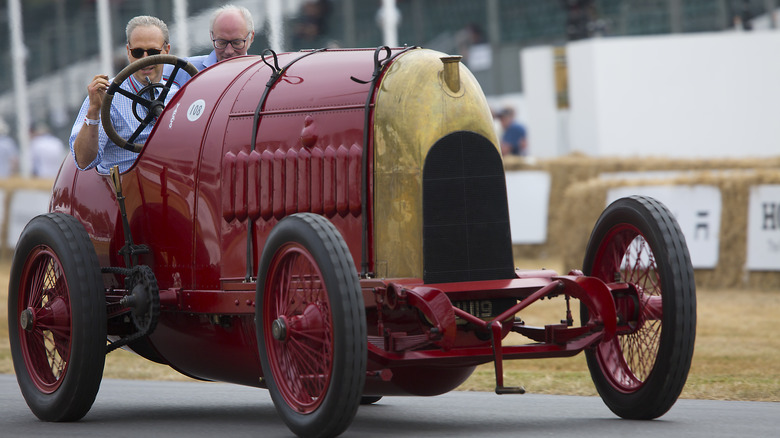Beast Of Turin: The 1910 Fiat S76 That Was Brought Back From The Grave
Recently, we wrote about the largest contemporary engines ever sold in the United States, with Dodge's 8.4-liter Viper V10 topping the list. Well, 8.4 liters is downright puny compared to what Fiat cooked up in 1911: a truly colossal 28.4-liter (1,730 cubic inches) four-cylinder engine in an attempt to best Carl Benz's "Blitzen Benz" land speed record of 126 MPH. Depending on the source, the S76's supersize four-cylinder — adapted from an airplane engine — was said to produce either 290 or 300 horsepower, which is unremarkable by modern standards, but bonkers for the time. The same year Ford Model T only made 20 horsepower.
Besides a ludicrous powerplant, the S76 also relied on a streamlined, albeit tall, body to reach terminal velocity. Although the coachwork was said to be made as thin as possible to reduce weight, the race car still tipped the scales at a portly 3,748 pounds. The chassis was very basic with solid axles front and rear, a chain drive, and terrifyingly, brakes fitted to the rear axle only.
Nicknamed "The Beast of Turin" after the Italian city where it was built, only two of the massive Fiats were ever produced. One was retained by the manufacturer and the second was sold to an affluent Russian Prince who hired an Italian racing driver named Pietro Bordino to make an attempt at the land speed record using the car. Reportedly, the S76 didn't inspire confidence at speeds over 90 MPH, so Bordino bailed on the effort. The Prince then hired American driver Arthur Duray to risk life and limb to set the record. Duray achieved a one-way pass of 132.27 MPH but unfortunately, a return run couldn't be completed, which was required to make the record official.
The signature engine had gone missing
Following the attempt at the land speed record, the ensuing decades of ownership for the second S76 were murky until it was acquired by British car collector Duncan Pittaway in 2003. However, one very important piece of the puzzle was missing: the signature engine. In a remarkable stroke of luck, Duncan was able to locate the engine from the first S76 car, which Fiat had dismantled at some point following World War I. Once the chassis and engine were reunited, a lengthy restoration was undertaken, with the bodywork and mechanicals rebuilt to specifications gleaned from the original Fiat design drawings and a scant few period photographs.
Fortunately for gearheads everywhere, Mr. Pittaway is a man who believes in enjoying his investment as more than just a static exhibit in a dusty museum. Since its restoration, the Beast of Turin has participated in several historic exhibition races, including the prestigious Goodwood Festival of Speed in England.
In a more recent and unexpected twist to the S76's story, an Italian museum claims that the massive 28.4-liter powerplant was part of the "Antonio Capetti Collection" at the Polytechnic of Turin and was merely loaned, not sold, to the English collector for purposes of examination. According to museum officials, the engine that was eventually returned by the Englishman was a counterfeit that was missing original parts. Whether the claim has a basis in reality or not, it's a safe bet that Beast of Turin won't be returning to Italy anytime soon for fear of potentially being confiscated until the matter is settled.
